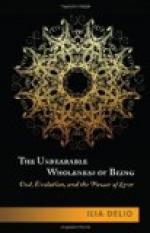(Transl. by D.G. ROSSETTI.)
And Guido Orlandi replies to him from the ecclesiastical standpoint, as to a lost man: “Had’st thou been speaking of Mary, thou would’st have spoken the truth. But now I must bewail thy errors.”
A complete blending of sensuality and Mary-worship was achieved in an Italian poem of the fifteenth century. The author of this poem addressed Mary as “queen of my heart,” and “blossom of loveliness,” and goes on to say: “I can tell by your gestures and your face that you respond to my love; when you look at me, you smile, and when you sigh, your eyes are full of tenderness.... Sometimes, in the evening, I stand below your balcony; you hear my sighs, but you make no reply.... When I gaze at your beauty, I burn with love, but when I think of your cruelty, I call on death to release me.” In this poem we have a caricature of metaphysical eroticism.
In the sonnets of Petrarch, metaphysical love has become stereotyped. Adoration has become a phrase (as Cupid has become a phrase with the earlier poets). It is obvious that he loves Laura because the play on the word Laura and lauro (laurel) caught his fancy. I can find no spontaneous feeling in the famous Canzoniero; all I see is erudition and perfection of form. But among the few sincere specimens there is one beautiful poem addressed to Mary: “Vergine bella che di sol vestida!” which is not without erotic warmth. But the singer and humanist expresses himself judiciously:
Oh, Thou, the Queen
of Heaven and our goddess
(If it be fitting such
a phrase to use).
So far we have observed the current which, emanating from the beloved woman, lifted her into supernal regions and endowed her with perfection—the mistress is stripped of everything earthly, the longing which can never be stilled on earth, soars heavenward. Now we will examine the opposite current; the current which emanates from the Madonna of dogma, the Lady of Heaven who is the same to all men, in her last stage, that is to say when she is finally enthroned by the side of God. Many a monk—earthly love being denied to him—was driven to a purely spiritual, metaphysical love by the fact of his being permitted to love the Lady of Heaven without hesitation or remorse. She was the fairest of women, and he was at liberty to interpret the meaning of “the fairest” in any sense he chose.
The climax of the emotional worship of the ecclesiastical Mary was reached by St. Bernard, the Doctor Marianus mentioned on a previous occasion. He was the author of sermons and homilies in honour of Mary, and has been instrumental in dogmatising her worship by placing her side by side with the Saviour. “It was more fitting that both sexes should take part in the renewal of mankind,” he says, “because both were instrumental in bringing about the fall....” “Man who fell through woman, can be raised only by her.” “Humanity kneels at Thy feet, for the comfort




